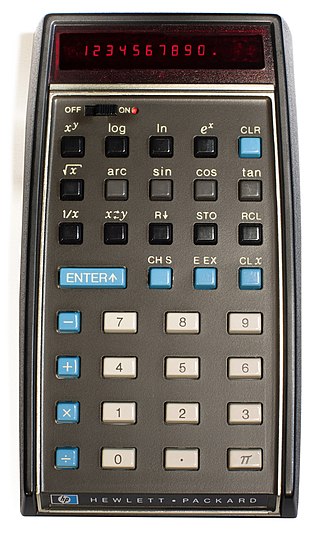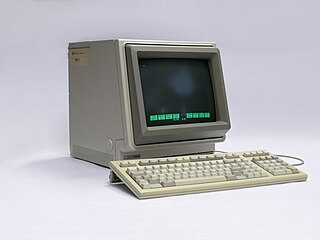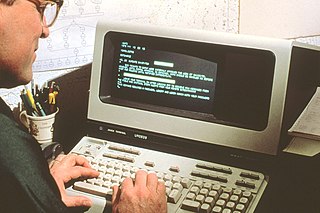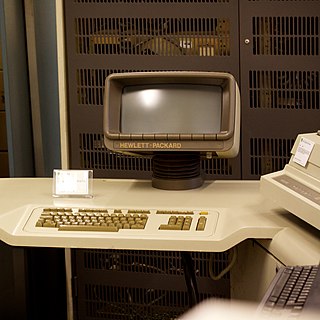
A minicomputer, or colloquially mini, is a type of smaller general-purpose computer developed in the mid-1960s and sold at a much lower price than mainframe and mid-size computers from IBM and its direct competitors. In a 1970 survey, The New York Times suggested a consensus definition of a minicomputer as a machine costing less than US$25,000, with an input-output device such as a teleprinter and at least four thousand words of memory, that is capable of running programs in a higher level language, such as Fortran or BASIC.

Precision Architecture RISC (PA-RISC) or Hewlett Packard Precision Architecture, is a general purpose computer instruction set architecture (ISA) developed by Hewlett-Packard from the 1980s until the 2000s.

HP-UX is Hewlett Packard Enterprise's proprietary implementation of the Unix operating system, based on Unix System V and first released in 1984. Current versions support HPE Integrity Servers, based on Intel's Itanium architecture.

IEEE 488, also known as HP-IB and generically as GPIB, is a short-range digital communications 8-bit parallel multi-master interface bus specification developed by Hewlett-Packard. It subsequently became the subject of several standards.

Apollo Computer Inc., founded in 1980 in Chelmsford, Massachusetts, by William Poduska and others, developed and produced Apollo/Domain workstations in the 1980s. Along with Symbolics and Sun Microsystems, Apollo was one of the first vendors of graphical workstations in the 1980s. Like computer companies at the time and unlike manufacturers of IBM PC compatibles, Apollo produced much of its own hardware and software.

The HP-35 was Hewlett-Packard's first pocket calculator and the world's first scientific pocket calculator: a calculator with trigonometric and exponential functions. It was introduced in 1972.

The HP-IL, was a short-range interconnection bus or network introduced by Hewlett-Packard in the early 1980s. It enabled many devices such as printers, plotters, displays, storage devices, test equipment, etc. to be connected to programmable calculators such as the HP-41C, HP-71B and HP-75C/D, the Series 80 and HP-110 computers, as well as generic ISA bus based PCs.

The HP 3000 series is a family of 16-bit and 32-bit minicomputers from Hewlett-Packard. It was designed to be the first minicomputer with full support for time-sharing in the hardware and the operating system, features that had mostly been limited to mainframes, or retrofitted to existing systems like Digital's PDP-11, on which Unix was implemented. First introduced in 1972, the last models reached end-of-life in 2010, making it among the longest-lived machines of its generation.
IMAGE is a database management system (DBMS) developed by Hewlett-Packard and included with the HP 3000 minicomputer. It was the primary reason for that platform's success in the market. It was also sometimes referred to as IMAGE/3000 in its initial release, and later versions were known as TurboIMAGE, and TurboIMAGE/XL after the PA-RISC migration.

HP 9000 is a line of workstation and server computer systems produced by the Hewlett-Packard (HP) Company. The native operating system for almost all HP 9000 systems is HP-UX, which is based on UNIX System V.

HP-150 was a compact, powerful and innovative computer made by Hewlett-Packard in 1983. It was based on the Intel 8088 CPU and was one of the world's earliest commercialized touch screen computers. Like other "workalike" IBM PC clones of the time, despite running customized MS-DOS versions 2.01, 2.11 and 3.20, the machine was not IBM PC DOS compatible. Its 8088 CPU, rated at 8 MHz, was faster than the 4.77 MHz CPUs used by the IBM PC of that period. Using add-on cards, main memory could be increased from 256 KB to 640 KB. However, its mainboard did not have a slot for the optional Intel 8087 math coprocessor due to space constraints. An HP-150 with an optional hard disk was called HP Touchscreen MAX.

The HP 300 "Amigo" was a computer produced by Hewlett-Packard (HP) in the late 1970s based loosely on the stack-based HP 3000, but with virtual memory for both code and data. The HP300 was cut-short from being a commercial success despite the huge engineering effort, which included HP-developed and -manufactured silicon on sapphire (SOS) processor and I/O chips.

The HP 2640A and other HP 264X models were block-mode "smart" and intelligent ASCII standard serial terminals produced by Hewlett-Packard using the Intel 8008 and 8080 microprocessors.

The Hewlett-Packard FOCUS microprocessor, launched in 1982, was the first commercial, single chip, fully 32-bit microprocessor available on the market. At this time, all 32-bit competitors used multi-chip bit-slice-CPU designs, while single-chip designs like the Motorola 68000 were a mix of 32 and 16-bit.

The Hewlett-Packard Series 80 of small scientific desktop computers was introduced in 1980, beginning with the popular HP-85 targeted at engineering and control applications. They provided the capability of the HP 9800 series desktop computers with an integrated monitor in a smaller package including storage and printer, at half the price.

The HP 250 was a multiuser business computer by Hewlett-Packard running HP 250 BASIC language as its OS with access to HP's IMAGE database management. It was produced by the General Systems Division (GSD), but was a major repackaging of desktop workstation HP 9835 from the HP 9800 series which had been sold in small business configurations. The HP 9835's processor was initially used in the first HP 250s.
In 1953, IBM recognized the immediate application for what it termed a "Random Access File" having high capacity and rapid random access at a relatively low cost. After considering technologies such as wire matrices, rod arrays, drums, drum arrays, etc., the engineers at IBM's San Jose California laboratory invented the hard disk drive. The disk drive created a new level in the computer data hierarchy, then termed Random Access Storage but today known as secondary storage, less expensive and slower than main memory but faster and more expensive than tape drives.

The HP 64000 Logic Development System, introduced 17 September 1979, is a tool for developing hardware and software for products based on commercial microprocessors from a variety of manufacturers. The systems assisted software development with assemblers and compilers for Pascal and C, provided hardware for in-circuit emulation of processors and memory, had debugging tools including logic analysis hardware, and a programmable read-only memory (PROM) chip programmer. A wide variety of optional cards and software were available tailored to particular microprocessors. When introduced the HP 64000 had two distinguishing characteristics. First, unlike most microprocessor development systems of the day, such as the Intel Intellec and Motorola EXORciser, it was not dedicated to a particular manufacturer's microprocessors, and second, it was designed such that up to six workstations could be connected via the HP-IB (IEEE-488) instrumentation bus to a common hard drive and printer to form a tightly integrated network.

The HP Integral PC is a portable UNIX workstation computer system produced by Hewlett-Packard, launched in 1985 at a price of £5450. It utilizes the Motorola 68000 microprocessor and ran the HP-UX 1.0 operating system.

The HP Prime Graphing Calculator is a graphing calculator introduced by Hewlett-Packard in 2013 and manufactured by HP Inc. until the licensees Moravia Consulting spol. s r.o. and Royal Consumer Information Products, Inc. took over the continued development, manufacturing, distribution, marketing and support in 2022. It was designed with features resembling those of smartphones, such as a full-color touchscreen display and a user interface centered around different applications. It claims to be the world's smallest and thinnest CAS-enabled calculator currently available.



















